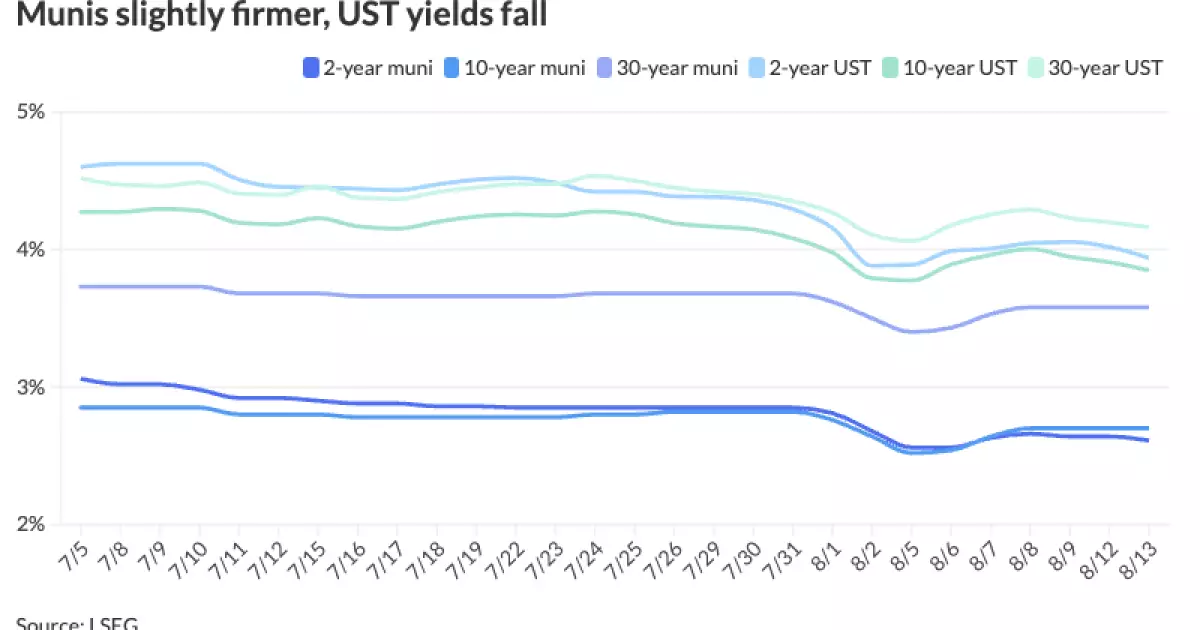The municipal bond market saw a decline in yields on Tuesday as the primary market activity picked up. This drop in yields occurred amidst an overall improvement in the U.S. Treasury market, as stocks surged following softer-than-expected inflation data. While Triple-A municipal curves experienced increases of two to four basis points, the most significant improvements were seen on the short end. In comparison, Treasury yields improved by four to eight basis points, with the largest movements also occurring on the short end. These shifts resulted in steady muni to UST ratios, with varying percentages across different terms. Despite the positive trend in the market, analysts remain cautious about potential overreactions to upcoming events.
AllianceBernstein strategists pointed out that the current week appears to be favorable due to a lighter new-issue calendar. Issuance for the week is estimated at $7.4 billion, nearly half of the previous week’s volume. Additionally, the reinvestment scheduled for August 15 is expected to inject roughly $21 billion into the market. While this may not be as significant as previous injections, it does provide a much-needed cash flow during a relatively calm week. The strategists also emphasized that employment data, rather than inflation, is the primary factor influencing the Federal Reserve’s decisions. As the market navigates through the influx of new issuances, the technical backdrop remains supportive.
Matt Fabian from Municipal Market Analytics highlighted the substantial primary supply that munis have been processing throughout the year. With issuance nearing $300 billion so far in 2024, the total volume is on track to exceed $450 billion by the year’s end. Fabian also pointed out the evolving nature of municipal demand, noting that recent fluctuations in exchange-traded fund redemptions and separately managed account transactions reflect changing investor behavior. As the market anticipates rate cuts from the Fed, underwriters face increasing pressure to offer attractive prices and spreads on primary offerings. However, one major concern is the diminishing seasonal reinvestment demand that has been supporting the market.
In the negotiated market, several bond offerings were priced for different entities, including the University of Houston, El Paso County Hospital District, Ohio, and the South Carolina Greenville-Spartanburg Airport District. These offerings feature a mix of taxable and tax-exempt bonds with varying maturities, aimed at meeting the financing needs of the respective issuers. Similarly, the competitive market saw transactions from entities like the Miami-Dade County School District and the North Dakota Public Financing Authority, among others. These bond sales represent a diverse range of projects funded through municipal bonds, highlighting the continued demand for such investments in the current market environment.
Refinitiv MMD, ICE Data Services, S&P Global Market Intelligence, and Bloomberg BVAL all reported adjustments in yield curves on Tuesday. While some scales showed improvements in various terms, others remained steady or saw minimal changes. Treasuries also experienced yield improvements across different maturities by the end of the trading day. These movements underscore the dynamic nature of fixed-income markets and the interplay between municipal and Treasury yields. As market participants continue to monitor economic data and Fed policy decisions, the impact on municipal yields remains a focal point for investors and analysts alike.
Overall, the municipal bond market continues to navigate through a range of factors, including new issuances, reinvestment flows, and changing investor preferences. While the recent market activity has shown signs of stability and resilience, challenges such as evolving demand dynamics and rate uncertainties pose significant risks. As market participants assess opportunities and risks in the current environment, careful monitoring of yield trends, supply-demand dynamics, and economic indicators will be crucial in making informed investment decisions.

